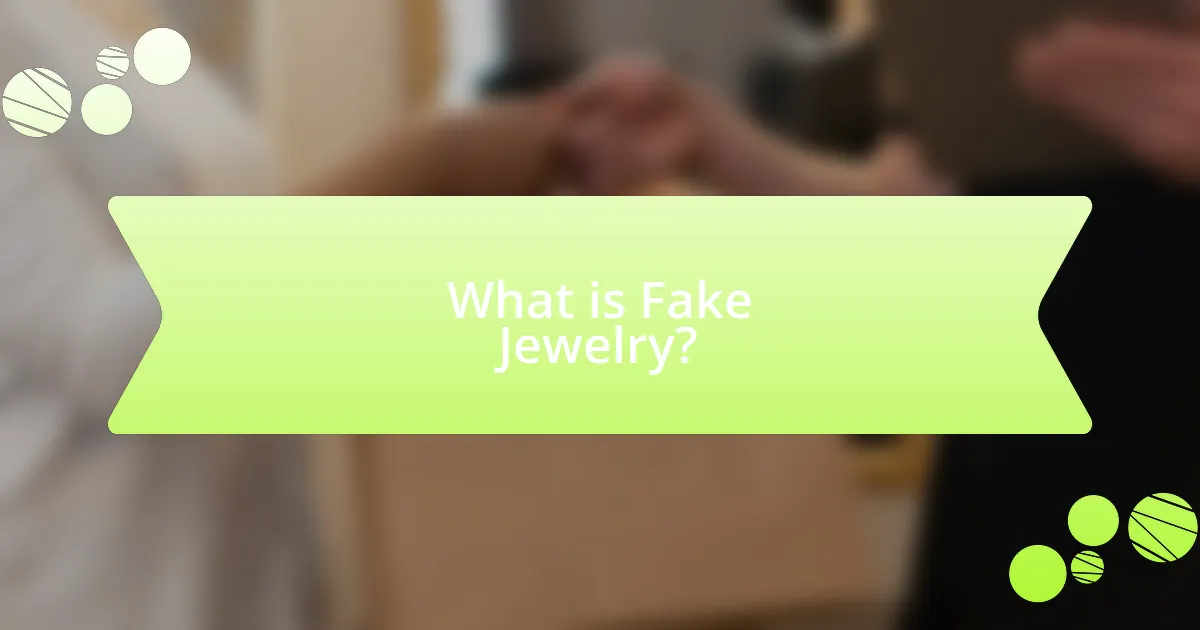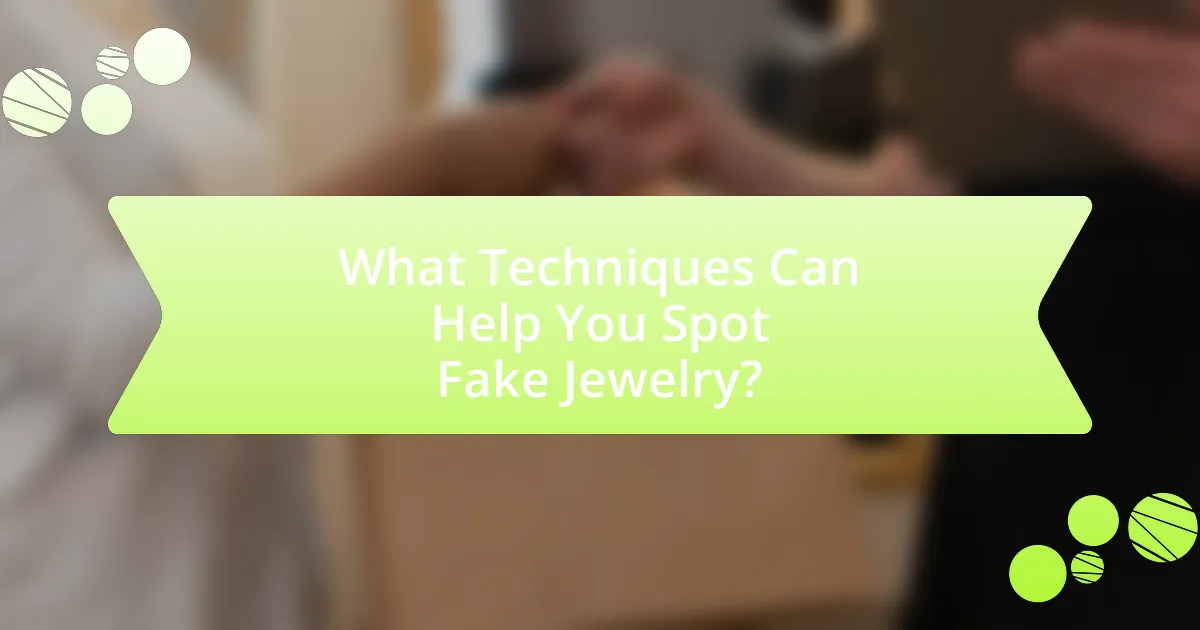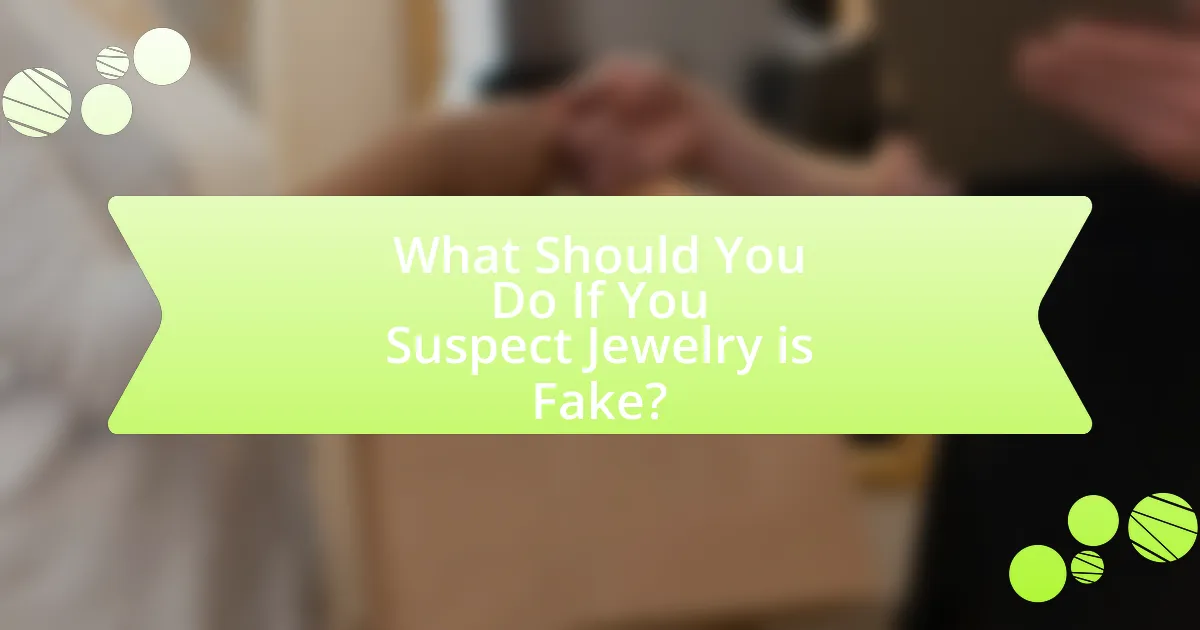Fake jewelry consists of accessories designed to imitate genuine precious metals and gemstones, often made from less valuable materials like plastic and base metals. Identifying fake jewelry involves examining weight, markings, and craftsmanship, as authentic pieces typically exhibit higher quality and specific density. The article outlines techniques for spotting counterfeit items, including magnet testing and visual inspection, while emphasizing the financial implications of purchasing fake jewelry and its negative impact on the jewelry market. Additionally, it provides guidance on verifying authenticity after purchase and best practices for avoiding counterfeit jewelry in the future.

What is Fake Jewelry?
Fake jewelry refers to accessories that are designed to mimic the appearance of genuine precious metals and gemstones but are made from less valuable materials. Common examples include costume jewelry, which often uses base metals, glass, or synthetic stones instead of gold, silver, or real gemstones. The distinction between fake and authentic jewelry is significant, as fake jewelry typically lacks the durability, value, and craftsmanship associated with genuine pieces.
How can you identify fake jewelry?
To identify fake jewelry, examine the piece for specific indicators such as weight, markings, and materials. Genuine gold jewelry, for instance, feels heavier than fake alternatives made from lighter metals. Additionally, authentic pieces often have stamps indicating their karat weight, while counterfeit items may lack these markings or display incorrect information. Furthermore, testing with a magnet can help; real gold and silver are not magnetic, whereas many fake items contain magnetic metals. Lastly, inspecting the craftsmanship reveals quality differences; authentic jewelry typically has finer details and smoother finishes compared to poorly made replicas.
What are the common materials used in fake jewelry?
Common materials used in fake jewelry include plastic, base metals like brass and copper, and synthetic stones such as cubic zirconia and glass. These materials are often chosen for their low cost and ability to mimic the appearance of genuine gemstones and precious metals. For instance, plastic is lightweight and can be easily molded into various shapes, while cubic zirconia is frequently used as a diamond substitute due to its similar optical properties.
How does the weight of jewelry indicate its authenticity?
The weight of jewelry is a key indicator of its authenticity because genuine precious metals and gemstones have specific densities that counterfeit materials often do not match. For instance, gold has a density of approximately 19.3 grams per cubic centimeter, while many fake alternatives, such as gold-plated or base metal items, are significantly lighter. This discrepancy in weight can be measured using a precise scale; authentic pieces will typically feel heavier than their counterfeit counterparts. Additionally, reputable jewelers often provide weight specifications for their products, which can be cross-referenced to verify authenticity.
Why is it important to spot fake jewelry?
It is important to spot fake jewelry to protect financial investments and ensure authenticity. Fake jewelry can significantly diminish value, leading to financial loss for buyers who may unknowingly purchase counterfeit items. According to a report by the Jewelers of America, counterfeit jewelry can be worth only a fraction of the price of genuine pieces, which can mislead consumers and collectors. Additionally, identifying fake jewelry helps maintain the integrity of the jewelry market, ensuring that artisans and legitimate businesses are not undermined by fraudulent products.
What are the financial implications of buying fake jewelry?
Buying fake jewelry can lead to significant financial losses, as it typically lacks resale value and may result in wasted expenditure. Authentic jewelry often appreciates over time, while counterfeit items do not hold their value and can be difficult to sell. According to a report by the Jewelers of America, consumers can lose up to 70% of their investment when purchasing fake pieces, as they are often sold at inflated prices under the guise of authenticity. Additionally, the cost of repairs or replacements for damaged fake jewelry can further compound financial implications, leading to ongoing expenses that genuine pieces would not incur.
How does fake jewelry affect the jewelry market?
Fake jewelry negatively impacts the jewelry market by undermining consumer trust and devaluing genuine products. The proliferation of counterfeit items leads to confusion among buyers, who may struggle to distinguish between authentic and fake pieces, ultimately resulting in decreased sales for legitimate jewelers. According to a report by the International AntiCounterfeiting Coalition, the global economic impact of counterfeiting, including jewelry, is estimated to be over $600 billion annually. This significant financial loss highlights the detrimental effects of fake jewelry on market integrity and brand reputation.

What Techniques Can Help You Spot Fake Jewelry?
To spot fake jewelry, utilize techniques such as magnet testing, visual inspection, and weight comparison. Magnet testing reveals that genuine gold and silver are not magnetic, while many fake pieces contain ferrous metals that will attract to a magnet. Visual inspection involves examining the jewelry for signs of poor craftsmanship, such as uneven surfaces, missing stones, or incorrect markings, as authentic pieces typically exhibit high-quality workmanship and proper hallmarks. Weight comparison is effective because genuine metals have specific densities; for instance, gold is denser than most fake alternatives, so a genuine gold piece will feel heavier than a counterfeit. These techniques are widely recognized in the jewelry industry for their effectiveness in distinguishing authentic items from imitations.
How can you use visual inspection to identify fake jewelry?
Visual inspection can identify fake jewelry by examining key characteristics such as metal quality, craftsmanship, and gemstone authenticity. Genuine jewelry typically features high-quality materials, with precious metals like gold or silver displaying appropriate hallmarks or stamps indicating their purity. In contrast, fake jewelry often uses lower-quality metals that may show signs of tarnishing or discoloration.
Additionally, the craftsmanship of authentic pieces is usually superior, with smooth edges, secure settings, and consistent finishes. Fake jewelry may exhibit rough edges, poorly set stones, or uneven surfaces. When inspecting gemstones, real stones often have unique inclusions or imperfections, while synthetic or fake stones may appear too perfect or have a uniform appearance.
By focusing on these visual cues, one can effectively differentiate between genuine and counterfeit jewelry.
What specific details should you look for in the craftsmanship?
When evaluating craftsmanship in jewelry, focus on details such as the quality of the setting, the precision of the stone placement, and the overall finish of the piece. High-quality craftsmanship will exhibit a secure and well-aligned setting, ensuring that stones are held firmly without gaps or misalignment. Additionally, the finish should be smooth and polished, with no visible scratches or rough edges, indicating careful attention to detail. For example, authentic pieces often feature hallmark stamps that denote the metal’s purity, which is a sign of reputable craftsmanship. These elements collectively demonstrate the skill and care invested in the creation of the jewelry, distinguishing genuine items from fakes.
How do hallmarks and stamps indicate authenticity?
Hallmarks and stamps indicate authenticity by providing a verified mark of quality and origin on precious metals and gemstones. These markings are typically regulated by national or international standards, ensuring that the metal content, such as gold or silver purity, meets specific criteria. For example, in the United States, the Federal Trade Commission mandates that jewelry must be accurately labeled with its metal content, while in the UK, the Assay Office certifies the metal’s purity through official hallmarks. This system helps consumers identify genuine products and protects them from counterfeit items, as each hallmark or stamp corresponds to a specific assay office or manufacturer, making it traceable and verifiable.
What tests can you perform at home to check for authenticity?
To check for authenticity of jewelry at home, you can perform several tests including the magnet test, the acid test, and the water test. The magnet test involves bringing a magnet close to the jewelry; genuine gold and silver are not magnetic, while many fake pieces are made from magnetic metals. The acid test requires applying a small drop of nitric acid to a discreet area; real gold will not react, while fake gold will change color. The water test involves placing the jewelry in water; real gold and silver will sink, while many fake pieces will float due to being made from lighter materials. These methods are commonly used and can provide immediate insights into the authenticity of jewelry.
How does the magnet test work for identifying fake jewelry?
The magnet test identifies fake jewelry by determining whether the metal is magnetic or not. Genuine gold and silver are non-magnetic, while many base metals used in counterfeit jewelry, such as iron or nickel, are magnetic. When a magnet is brought close to the jewelry, if it is attracted, it likely contains these magnetic metals, indicating it may be fake. This method is a quick and simple way to assess the authenticity of jewelry, as it relies on the fundamental properties of the metals involved.
What is the significance of the acid test in jewelry verification?
The acid test is significant in jewelry verification as it determines the authenticity and purity of precious metals, particularly gold and silver. This method involves applying a specific acid to the metal; if the metal is genuine, it will not react, while a reaction indicates a lower quality or fake material. Historically, the acid test has been a reliable technique since the 19th century, providing jewelers and consumers with a straightforward means to assess metal quality, thus preventing fraud and ensuring value in transactions.

What Should You Do If You Suspect Jewelry is Fake?
If you suspect jewelry is fake, you should first conduct a thorough examination of the piece for signs of authenticity. Look for hallmarks or stamps that indicate the metal’s quality, such as “925” for sterling silver or “750” for 18-karat gold. Additionally, check for any inconsistencies in the craftsmanship, such as rough edges or poorly set stones, which may indicate a counterfeit.
Next, consider performing a simple test, such as the magnet test; genuine gold and silver are not magnetic, while many fake pieces are made with magnetic metals. If doubts persist, consult a professional jeweler for a formal appraisal, as they possess the expertise and tools to accurately assess the jewelry’s authenticity.
These steps are crucial because counterfeit jewelry can often be identified through specific characteristics and tests, ensuring you make informed decisions regarding your purchase.
How can you verify the authenticity of jewelry after purchase?
To verify the authenticity of jewelry after purchase, you should obtain a professional appraisal from a certified gemologist. A certified gemologist can assess the jewelry’s materials, craftsmanship, and overall quality, providing a detailed report that confirms its authenticity. Additionally, reputable jewelers often provide certificates of authenticity for their pieces, which can serve as proof of the jewelry’s legitimacy. According to the Gemological Institute of America, a recognized authority in gemology, a professional appraisal is essential for confirming the quality and authenticity of gemstones and precious metals.
What resources are available for professional appraisals?
Professional appraisals for jewelry can be obtained through certified appraisers, appraisal organizations, and online appraisal services. Certified appraisers are individuals who have undergone training and certification, ensuring they possess the necessary expertise to evaluate jewelry accurately. Organizations such as the American Society of Appraisers and the International Society of Appraisers provide directories of qualified appraisers. Online appraisal services offer convenience and can provide assessments based on submitted photographs and descriptions, although they may lack the thoroughness of in-person evaluations. These resources ensure that individuals receive accurate and reliable appraisals for their jewelry.
How can you contact the seller for clarification or return?
To contact the seller for clarification or return, locate the seller’s contact information on the platform where the purchase was made, such as an email address or a messaging feature. Most online marketplaces provide a “Contact Seller” option within the order details, allowing direct communication. This method is effective as it ensures that your inquiry is directed to the appropriate party, facilitating a quicker response regarding your concerns or return requests.
What steps can you take to avoid buying fake jewelry in the future?
To avoid buying fake jewelry in the future, always purchase from reputable retailers or certified jewelers. Reputable retailers often provide authenticity certificates for their products, ensuring that the jewelry is genuine. Additionally, familiarize yourself with hallmark stamps, which indicate the metal’s purity and authenticity; for example, gold jewelry should have a stamp like 14K or 18K. Furthermore, inspect the jewelry closely for quality craftsmanship, as fake pieces often exhibit poor workmanship, such as uneven settings or lack of detail. Lastly, research customer reviews and ratings to gauge the retailer’s reliability and the authenticity of their products.
What are the best practices for purchasing jewelry online?
The best practices for purchasing jewelry online include researching the seller, verifying authenticity, and understanding return policies. Researching the seller involves checking reviews and ratings on platforms like Trustpilot or the Better Business Bureau, which can indicate reliability. Verifying authenticity requires looking for certifications from recognized gemological laboratories, such as GIA or AGS, which provide assurance of the jewelry’s quality. Understanding return policies is crucial, as reputable sellers typically offer a clear return or exchange policy, allowing customers to return items if they do not meet expectations. Following these practices helps ensure a safe and satisfactory online jewelry purchase.
How can you educate yourself about reputable jewelers?
To educate yourself about reputable jewelers, research their credentials, customer reviews, and industry affiliations. Start by checking if the jeweler is a member of recognized organizations such as the American Gem Society or the Jewelers of America, which require adherence to ethical standards. Additionally, read customer reviews on platforms like Yelp or Google to gauge the experiences of previous clients. According to a 2021 survey by the Jewelers of America, 85% of consumers trust jewelers who are members of professional organizations, indicating that membership can be a reliable indicator of a jeweler’s reputation.
What are some practical tips for spotting fake jewelry?
To spot fake jewelry, examine the piece for signs of authenticity such as weight, markings, and materials. Genuine jewelry typically feels heavier than its fake counterparts due to the density of real metals like gold or silver. Check for stamps or hallmarks indicating the metal’s purity; authentic pieces often have markings like “925” for sterling silver or “750” for 18k gold. Additionally, inspect the craftsmanship; real jewelry usually features high-quality finishes and settings, while fake jewelry may have rough edges or poorly set stones. Lastly, perform a magnet test; real gold and silver are not magnetic, while many fake pieces are made from cheaper metals that can be attracted to a magnet.
